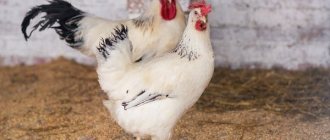Home » Articles about chickens » Rhodonite chicken breed
The first 2 lines of the hybrid breed of Rhodonite chickens were bred by German breeders. In Russia, the work was continued - the resulting cross rhodonite-3 is well adapted to the conditions of the Russian climate.
Origin story
Poultry breeding work began in 2002, when breeders from Sverdlovsk tried to obtain chickens with maximum egg production.
Also important in the work was the selection of individuals that can easily tolerate harsh climatic conditions.
Until 2008, significant success was not achieved. Good results were obtained by crossing Loman Brown and Rhode Island chickens, which have high productive qualities.
Externally, Rhodonite laying hens are very similar to their parents, which is why an inexperienced poultry farmer can easily confuse them with each other.
Comparison of parent breeds and hybrid in the table below:
The resulting bird turned out to be resilient, not losing its egg production even at sub-zero temperatures.
In addition, its productivity relative to eggs is today the highest in the world.
Flaws
In winter, feed consumption for production increases due to the fact that chickens spend more of their feed than in summer on heat production. Poultry farmers complain about the meat quality of the meat. However, this drawback is typical for all egg-cross chickens.
Meat and egg productivity are inversely related. Thus, meat chickens lay eggs and their feed consumption for products is several times higher. But the cost of feed for the growth of broilers is many times lower than the same figure for raising males of egg breeds.
At the same time, the carcasses of Rhodonite chickens produce excellent broth and delicious jellied meat.
Suitable region and climate
Red chickens have adapted well to Russian climatic conditions. The breeding of the latest line of Rhodonit-3 was carried out by breeders in Yekaterinburg, who sought to create a well-bearing breed at low (minus) ambient temperatures.
At first, the cross was designed for industrial cultivation, but it was soon appreciated by private farmers and poultry farmers.
Therefore, this cross can be found on many farms in various regions of Russia, especially with cold and long winters.
Video
We invite you to watch several videos filmed by experienced poultry farmers who work with Rodonite chickens and share tips from their own practice:
About the author:
Found a mistake? Select the text with the mouse and click:
Ctrl + Enter
Do you know that:
A new product from American developers is the Tertill robot, which weeds weeds in the garden. The device was invented under the leadership of John Downes (creator of the robot vacuum cleaner) and works autonomously in all weather conditions, moving over uneven surfaces on wheels. At the same time, it cuts off all plants below 3 cm with the built-in trimmer.
Description of the breed
Photo:
Rhodonite chickens have a small head with a neat yellow beak, with a leaf-shaped crest, relatively large and deep red. The earrings, well defined, are also red.
The plumage of chickens is dense and fits well to the body, which is why they feel comfortable even at low temperatures without stopping egg laying.
The color of the bird is light brown with a slight tint on the tail and wings. The body of chickens is light with a convex chest.
After the chicks hatch, during the first day you can easily distinguish males from females.
At the age of day old chicks, Rhodonite chickens have brown fluff on the body and a white head. The cockerel differs from them in having a dark spot on its head and yellow down.
There are 2 lines of the breed: rhodonite 3 and 2. They are distinguished from all other breeds by their high productivity, almost 100% survival rate and easy adaptability to various conditions.
External deviation from the breed standard does not result in loss of egg production. Since the bird was bred recently, individuals with some deviations in plumage appear quite often.
Character
Birds have a balanced, calm, fearless disposition. They prefer an active lifestyle and are very mobile. “Movement is life” is their motto.
They need to constantly move, so they make a larger walk for them to give them this opportunity.
They behave friendly with other birds and with their relatives, aggressive behavior is alien to them.
They quickly get used to new conditions, do not experience anxiety or stress when moving, so they immediately begin to lay eggs as soon as they settle in a permanent place. They quickly get used to their owner, are not afraid of her and do not run away when she appears.
Egg production, productivity
This is a cross that is characterized by high egg production. Laying hens can produce up to 350 eggs/year, with an average of 280 to 350 eggs. They begin to lay eggs early; the first eggs can already be collected from four-month-old young hens.
Eggshells are colored brown, in light or dark colors. Some poultry farmers describe the color of the shell as brown with a burgundy tint. They are small in size, one egg weighs on average 60 g.
The greatest productivity is observed in the first year and a half.
In two-year-old laying hens, egg production begins to decline quickly, so on poultry farms the stock is usually changed after 1.5-2 years; on private farms and farmsteads they are kept for up to 3-4 years.
However, laying hens are given a so-called “rejuvenation” vaccine, and their productivity is restored for another 80 weeks.
Raising cockerels for meat is not practical, as their taste leaves much to be desired.
The maximum weight of males reaches only 3.5 kg. The meat is tough and is only suitable for cooking broths or soups, and for industrial processing.
Productivity
Rodonit hens begin to lay eggs very early: at 16-17 weeks , and quickly reach peak productivity. The eggs have an average weight of 64 g and a brown shell. One laying hen can produce about 300 eggs per year (if she is fed properly). The consumer quality of the products is assessed as very high. At the age of one and a half years, egg production decreases. To extend the productive period, a chicken can be given a specially developed “anti-aging vaccine” (SSYA-76). Unfortunately, the drug is quite expensive, and its use in private farming is not considered profitable.
Laying hens are distinguished by their early entry into productive age and very good egg performance
Some amateur poultry farmers recommend replacing this procedure by adding yeast nutrition to the diet of laying hens, which supposedly acts on the bird’s body in a similar way to a “vaccine” and allows you to extend the egg-laying period for another year and a half. However, most private owners do not resort to such methods, preferring to simply renew the productive flock, replacing “aged” birds with newly purchased young animals.
The carcasses of Rhodonite hens and cockerels that were culled are used for cooking, but the quality of their meat, to put it mildly, is “not impressive”: it is stringy and tough, unsuitable for frying or baking. Therefore, the cross is used everywhere exclusively as an egg.
Reviews
According to farmers, rhodonite has a number of advantages:
- Early and high egg production.
- Frost resistance - laying hens can withstand frosts down to -20 ° C and continue to lay eggs at sub-zero temperatures. To maintain good productivity in winter, the temperature in the chicken coop should be maintained above -2 °C. When the temperature rises above +28 °C, egg production also decreases.
- High vitality. The hatchability of chickens is 87%, the survival rate of young animals up to 17 weeks is 99%, the survival rate of 17-80 week old females is 97%.
- Quick adaptation to new conditions.
- Birds are easy to care for.
The main disadvantage of rhodonite is the lack of a “brooding instinct,” which entails the loss of eggs. Chickens can lay eggs anywhere if they are free-range.
When breeding, the incubation method is used, but the characteristics of this cross will not be transferred to the chickens, moreover, they will be weak, small and lay little eggs.
Experts also note that one of the disadvantages is the low meat yield.
What to feed?
In the process of caring for representatives of the rhodonite cross, special attention must be paid to their diet. Veterinarians and scientists report that the best food option for such animals will be ready-made combined mixtures, as well as so-called mash
If desired, you can add meat and fish broths to these complexes.
In addition, it is recommended to add other products to the base, in particular vegetables, herbs and wheat cereals. If there is a need to introduce any vitamins or minerals into the diet, as well as any artificial additives, you should consult your veterinarian in advance. Otherwise, this can lead to the development of a disease such as hypervitaminosis in chickens. Livestock breeders also note that rhodonite chickens are especially fond of wheat and corn cereals.
If you want to add any useful additives to your homemade bird food, then components such as crushed chalk or parsley can play their role. They are able to maintain the level of calcium in the chicken’s body at the required level for the normal growth and development of the animal. If the calcium level is too low, this can lead to a wide variety of negative consequences, for example, chickens will begin to lay eggs with too thin a shell or without it at all.
In order to activate the gastrointestinal tract and digestive system of the animal, you can also add a small amount of sand to the food.
Thus, in order to produce 10 eggs, a chicken must consume 1.5 kilograms of food.
Breeding
The bird's incubation instinct is completely lost, and it will not be possible to place the female on the eggs. To hatch chicks, you must use an incubator or a hen of a different breed.
The characteristics of rhodonite roosters are very good: they perform their duties efficiently, ensuring egg fertility of about 97%.
The correct sex ratio in the herd allows you to obtain high-quality incubation material. For 4 hens you need 1 rooster.
When there is only 1 rooster in the herd, and there are many females, to obtain a fertilized egg, it is best to place 4 hens with a male separately for a couple of weeks. The egg obtained from these laid out females must be put into incubation.
Raising chickens
Raising chickens is not difficult, but it requires compliance with certain rules. Poultry chicks have minimal mortality and often the entire brood survives to adulthood.
Immediately after hatching, the chick is transferred from the incubator to a brooder or heated box. It is best to warm young animals using an infrared lamp.
If there are few chicks, then you can warm them up using a blue lamp. The bottom of the box is covered with soft white cotton cloth, and in the brooder it is covered with sawdust.
The chicks should be fed immediately after they are dry. They should be given a hard-boiled egg, finely chopped along with the shell. They should also be given some crushed wheat.
The egg is left for 30 minutes, after which everything uneaten is removed so that the food does not begin to deteriorate. Crushed cereal is left for babies around the clock so that they can eat as soon as they want.
From the second day, cottage cheese and greens are introduced into the diet of young animals. Vitamin supplements are also started. From 2 weeks, the chicks begin to be fed little by little with fish and meat (can be replaced with worms).
To raise high-quality laying hens, you need to give your chickens green onions every day.
The drinking bowl should always be available. Its contents are changed at least 3 times a day, since even slightly spoiled water will cause serious problems with the chickens.
In the first days, you can add a little potassium permanganate to the water: after it is dissolved, the water should practically not change color.
Chicks are taken out for walking in warm and dry weather, starting at 2 weeks. Young animals are left to roam all day long in good weather from the age of 1 month.
Even a beginner can grow rhodonite, but, of course, if all recommendations are followed. Chicks do not require special conditions, which is especially appreciated by breeders.
Raising chickens
Laying hens of the Rhodonite breed are kept in a brooder, gradually lowering the temperature. Under the heater at the beginning of the process this indicator is +34...+35°C, at the final stage it should be within +18...+24°C. The room temperature decreases from +24…+26°C to +16…+19°C. Humidity – 60-70%.
During the first week, the lighting is left on for 23 hours. From the 8th to the 14th day, the duration of daylight hours is reduced daily, ultimately bringing it to 15 hours. Next week the process continues - the light period by day 21 should be 12 hours. By the age of one month, this parameter is increased to 7 hours. Lighting intensity – 3 W/sq.m.
Content
Rhodonite - chickens are unpretentious, and keeping them is not difficult. For them, it is only important to provide a draft-free shed (you can use a polycarbonate greenhouse) and a paddock where they can expend energy.
In order for the chickens to feel comfortable at night, they are given roosts. The nests should be the size of the chickens and attached to the wall at a height of about 80 cm. Ideally, 1 nest should be made for 3 chickens.
The floor of the poultry house should be well covered with sand, peat moss, hay or sawdust.
Rhodonite chicken, like any other, does not like dampness, and therefore it is necessary to maintain a comfortable environment in the poultry house. A chicken coop with an area of 10 m2 is enough for 20 birds.
To ensure that egg production does not decrease, in winter the temperature in the poultry house is maintained at least -2 degrees.
The bird will not die even at -20, but its laying will become much worse: once every 3–4 days. Heat is also not good for laying hens, and if the house is warmer than +28 degrees, the number of eggs will decrease significantly.
To cool the chicken coop, use either a ventilation system or, at home, wet sheets hung on 2 walls.
Care
Caring for a bird is not at all difficult. To ensure that representatives of the breed of chickens do not get sick, it is necessary to ventilate the poultry house in a timely manner, and also clean it 3 times a year.
To prevent the appearance of parasites, once a year the walls of the barn are whitewashed with lime. In the summer, it is good to treat the chicken coop in the absence of birds with special antiseptic bombs.
When walking, you need to make a fence high enough so that the rhodonites do not flutter over it. Their wings are quite strong and, with a low weight, rhodonites can overcome a barrier of 150 cm.
Birds are checked for parasites in their feathers once a month. To inspect, the bird should be lifted by the legs and held with your hand against the feathers, carefully looking at their awns.
If parasites are found, laying hens should be treated with a special product for productive birds or, if the flock is small, with Bars flea drops for cats. Their quantity is calculated based on the weight of the chicken.
If the care is satisfactory, then the hens lay eggs regularly and do not get sick. If the condition of the pets worsens, you need to look for your mistakes in their maintenance.
Tendency to disease
Since the breed is very hardy, it has good immunity, which provides high resistance to diseases. If inflammatory processes occur in the bird’s body (which is quite rare), then there is an error in the conditions of keeping and caring for the chickens. If you clean the chicken coop on time (at least once a month), and whitewash the walls and wooden components of the poultry house in spring and autumn, you can safely avoid infection with any infections.
Periodic preventive examinations include examining the chickens' feathers for the presence of foreign objects, including mites and other insects. If any deviations from the norm are detected, the diseased parts of the body are treated with insecticides. Bathing in sand and ash, as a unique method of chicken hygiene, allows you to get rid of parasites, so it is advisable to place wide, knocked down boxes with such fillers in the walking area.
Some of the most common infections and inflammations include the following:
- pullorosis, a frequent consequence of which is death (closed eyes, drooping wings, lack of appetite, excessive breathing, thirst, diarrhea or, conversely, constipation);
- gastroenteritis (symptoms of intestinal disorder);
- mycoplasmosis (swelling under the eyes, sounds and screams previously unusual for the bird);
- parasitic inflammation caused by helminths, ticks, fleas or bedbugs (diarrhea, loose stools, bloating, vomiting, unpleasant odor from the beak, general lethargy, fatigue and exhaustion);
- pasteurellosis (foamy nasal discharge with mucus, fever, yellow feces);
- salmonellosis (depression, drowsiness, muscle weakness, difficulty breathing, nasal discharge, sometimes lacrimation);
- coccidiosis - damage to the mucous membrane of the gastrointestinal tract of poultry (frequent diarrhea with the presence of mucous, sometimes bloody elements);
- bronchitis (reduced level or absence of egg production, cough, wheezing, apathy, drowsiness, heaviness in breathing, constant opening of the beak, subsequent addition of conjunctivitis and rhinitis);
- tuberculosis (sharp weight loss due to complete lack of appetite, pallor of the comb, wrinkled earrings).
Salmonellosis is the most dangerous possible disease, since it can be transmitted to humans through contaminated eggs and meat.
Feeding
In order for chickens to lay eggs efficiently, it is necessary to provide them with a balanced diet. Without it, the bird begins to suffer from a lack of certain substances in the body and, as a result, loses its productivity.
The basis of the diet should consist of special feed for laying hens.
Chickens should also be given:
- grain mixture;
- vegetables;
- potato;
- greenery.
In winter, for additional vitaminization, feeding the birds with dry nettle is recommended.
Food is given in the morning and evening. If chickens do not have time to eat the portion given to them in 30 minutes, this means that they are overfed. D
It is undesirable to use special premixes for maximum egg production, since they destroy the bird’s body and do not allow it to be kept for more than 1 year.
In addition to food, the bird should receive food shells and coarse river sand.
Water, clean and fresh, must be available at all times. It should be changed at least once a day.
In extreme heat, as well as damp, cold weather, the risk of infectious diseases in birds increases, and it is good to add a couple of potassium permanganate crystals to the drinking bowl for prevention.
Also for this purpose, it is good to feed chickens with a decoction of calendula flowers. The plant is a strong natural antiseptic, which also improves the color of the yolk.
Diseases
Rhodonite chickens, like other poultry, are susceptible to a number of diseases. The healthier the hens are, the more productive they are. The main condition that is necessary for disease prevention is keeping the chicken coop clean. It is necessary to regularly disinfect the premises. Chickens should not starve; they should always have access to saturate their body with minerals, vitamins and other beneficial substances.
There are the following diseases that occur in rhodonite chickens:
- gastroenteritis - develops due to eating low-quality food. For treatment, it is enough to remove the bad product from the diet, but in some situations the intervention of antibiotics will be required;
- Salmonellosis is the most common disease among birds. In addition to the danger the disease poses to poultry, it is also dangerous to humans. Transmitted to humans through eggs, meat, milk;
- In chicken coops where there are drafts, birds may develop bronchitis. The chicken almost completely stops laying eggs, and roughness appears on the shell. When incubating such eggs, chicks are doomed to death after birth;
- Pollorosis - affects young individuals. Symptoms include drooping wings, closing eyes, and refusal to eat. It is impossible to avoid death in such a situation;
- Tuberculosis - affects the lungs, but can also affect other organs, such as bones. The hen completely stops laying eggs, refuses food and loses weight. The comb becomes pale in color and the skin on the earrings wrinkles. Once the diagnosis is confirmed, the bird is slaughtered.
Rhodonite chickens are more susceptible to diseases. But adult laying hens often suffer from a number of the listed diseases. Diseases directly affect egg production. To prevent chickens from getting sick, it is necessary to carry out sanitary measures and keep the chicken coop constantly clean. Remove sick birds from the flock, and keep healthy ones under supervision.
https://youtube.com/watch?v=qw2fofXY5Cg
https://youtube.com/watch?v=pxHDLMYQ2SQ
Price
The cost of poultry is not at all high, and day-old chicks can be purchased on farms for 30 rubles per head. Pullets are sold for 350–450 rubles.
Photo gallery
Features of temperament
Crosses have a fairly balanced and calm temperament, which allows them to get along with other varieties of poultry without showing any aggression. They get used to their owner almost immediately and are not afraid of people.
In addition, chickens have incredible resistance to stress, and pullets begin laying eggs literally immediately after moving to their permanent place of residence.
Since crosses spend most of their time on the move, preferring to lead an active lifestyle, for their normal maintenance and breeding it is necessary to build a spacious poultry house and prepare a walking area. They do not feel very comfortable in a cramped cage, which negatively affects their productivity.
As a summary
In this article we touched on the main and most significant features of Rhodonite chickens. What are the reviews? Summarizing the main characteristics, we can display the following graph of the advantages of the cross:
- high egg production;
- satisfactory survival of young animals;
- adaptability to bear at negative temperatures.
Whether to start breeding this selection or to abstain – the decision must be made personally by the applicant. Experts recommend buying chickens from large poultry farms.
It is not difficult to distinguish females and males, and the presence of a “commander” in the flock is completely unnecessary if your plans do not include offspring. The egg production rate of laying hens is not “tied” to this factor.
However, experienced poultry farmers recommend having at least one leader to maintain “discipline” in the chicken coop.
It can be additionally noted that this hybrid will be an excellent start for beginners planning to start a poultry farm or, moreover, to open their own business.
That's basically it. Prosperity and success to you!
Don’t forget to subscribe to site updates to be the first to receive new articles about cockerels and quons. Share the material with your friends on social networks - they will also be interested in reading about highly productive laying hens.
Did you like our tips? Share with friends on social media. networks!











